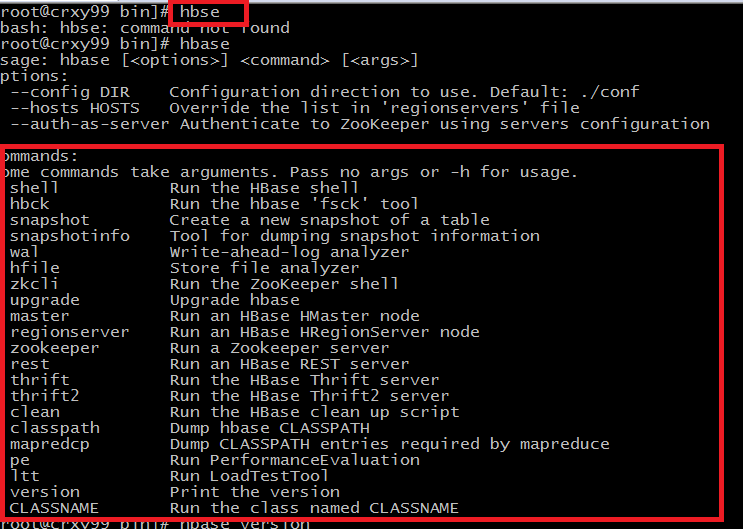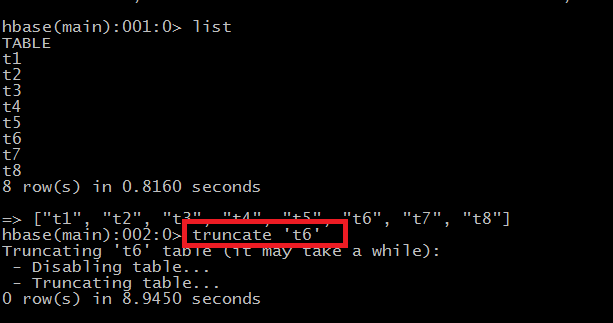一、显示hbase帮助命令,输入“hbase”按回车键

二、hbase version 查看hbase的版本号,同时给出该版本号对应的源码在git上的位置

三、对表进行turncate操作,此操作实际进行两个动作,先停用该表,然后在清空表中的数据。

四、修改hbase表结构:alter
参数介绍:
alter
ERROR: wrong number of arguments (0 for 1)
Here is some help for this command:
Alter a table. If the "hbase.online.schema.update.enable" property is set to
false, then the table must be disabled (see help 'disable'). If the
"hbase.online.schema.update.enable" property is set to true, tables can be
altered without disabling them first. Altering enabled tables has caused problems
in the past, so use caution and test it before using in production.
You can use the alter command to add,
modify or delete column families or change table configuration options.
Column families work in a similar way as the 'create' command. The column family
specification can either be a name string, or a dictionary with the NAME attribute.
Dictionaries are described in the output of the 'help' command, with no arguments.
For example, to change or add the 'f1' column family in table 't1' from
current value to keep a maximum of 5 cell VERSIONS, do:
hbase> alter 't1', NAME => 'f1', VERSIONS => 5
You can operate on several column families:
hbase> alter 't1', 'f1', {NAME => 'f2', IN_MEMORY => true}, {NAME => 'f3', VERSIONS => 5}
To delete the 'f1' column family in table 'ns1:t1', use one of:
hbase> alter 'ns1:t1', NAME => 'f1', METHOD => 'delete'
hbase> alter 'ns1:t1', 'delete' => 'f1'
You can also change table-scope attributes like MAX_FILESIZE, READONLY,
MEMSTORE_FLUSHSIZE, DURABILITY, etc. These can be put at the end;
for example, to change the max size of a region to 128MB, do:
hbase> alter 't1', MAX_FILESIZE => '134217728'
You can add a table coprocessor by setting a table coprocessor attribute:
hbase> alter 't1',
'coprocessor'=>'hdfs:///foo.jar|com.foo.FooRegionObserver|1001|arg1=1,arg2=2'
Since you can have multiple coprocessors configured for a table, a
sequence number will be automatically appended to the attribute name
to uniquely identify it.
The coprocessor attribute must match the pattern below in order for
the framework to understand how to load the coprocessor classes:
[coprocessor jar file location] | class name | [priority] | [arguments]
You can also set configuration settings specific to this table or column family:
hbase> alter 't1', CONFIGURATION => {'hbase.hregion.scan.loadColumnFamiliesOnDemand' => 'true'}
hbase> alter 't1', {NAME => 'f2', CONFIGURATION => {'hbase.hstore.blockingStoreFiles' => '10'}}
You can also remove a table-scope attribute:
hbase> alter 't1', METHOD => 'table_att_unset', NAME => 'MAX_FILESIZE'
hbase> alter 't1', METHOD => 'table_att_unset', NAME => 'coprocessor$1'
You can also set REGION_REPLICATION:
hbase> alter 't1', {REGION_REPLICATION => 2}
There could be more than one alteration in one command:
hbase> alter 't1', { NAME => 'f1', VERSIONS => 3 },
{ MAX_FILESIZE => '134217728' }, { METHOD => 'delete', NAME => 'f2' },
OWNER => 'johndoe', METADATA => { 'mykey' => 'myvalue' }
附录:
COMMAND GROUPS:
Group name: general
Commands: status, table_help, version, whoami
Group name: ddl
Commands: alter, alter_async, alter_status, create, describe, disable, disable_all, drop, drop_all, enable, enable_all, exists, get_table, is_disabled, is_enabled, list, locate_region, show_filters
Group name: namespace
Commands: alter_namespace, create_namespace, describe_namespace, drop_namespace, list_namespace, list_namespace_tables
Group name: dml
Commands: append, count, delete, deleteall, get, get_counter, get_splits, incr, put, scan, truncate, truncate_preserve
Group name: tools
Commands: assign, balance_switch, balancer, balancer_enabled, catalogjanitor_enabled, catalogjanitor_run, catalogjanitor_switch, close_region, compact, compact_mob, compact_rs, flush, major_compact, major_compact_mob, merge_region, move, normalize, normalizer_enabled, normalizer_switch, split, trace, unassign, wal_roll, zk_dump
Group name: replication
Commands: add_peer, append_peer_tableCFs, disable_peer, disable_table_replication, enable_peer, enable_table_replication, get_peer_config, list_peer_configs, list_peers, list_replicated_tables, remove_peer, remove_peer_tableCFs, set_peer_tableCFs, show_peer_tableCFs, update_peer_config
Group name: snapshots
Commands: clone_snapshot, delete_all_snapshot, delete_snapshot, list_snapshots, restore_snapshot, snapshot
Group name: configuration
Commands: update_all_config, update_config
Group name: quotas
Commands: list_quotas, set_quota
Group name: security
Commands: grant, list_security_capabilities, revoke, user_permission
Group name: procedures
Commands: abort_procedure, list_procedures
Group name: visibility labels
Commands: add_labels, clear_auths, get_auths, list_labels, set_auths, set_visibility
Group name: rsgroup
Commands: add_rsgroup, balance_rsgroup, get_rsgroup, get_server_rsgroup, get_table_rsgroup, list_rsgroups, move_servers_rsgroup, move_tables_rsgroup, remove_rsgroup
SHELL USAGE:
Quote all names in HBase Shell such as table and column names. Commas delimit
command parameters. Type <RETURN> after entering a command to run it.
Dictionaries of configuration used in the creation and alteration of tables are
Ruby Hashes. They look like this:
{'key1' => 'value1', 'key2' => 'value2', ...}
and are opened and closed with curley-braces. Key/values are delimited by the
'=>' character combination. Usually keys are predefined constants such as
NAME, VERSIONS, COMPRESSION, etc. Constants do not need to be quoted. Type
'Object.constants' to see a (messy) list of all constants in the environment.
If you are using binary keys or values and need to enter them in the shell, use
double-quote'd hexadecimal representation. For example:
hbase> get 't1', "key\x03\x3f\xcd"
hbase> get 't1', "key\003\023\011"
hbase> put 't1', "test\xef\xff", 'f1:', "\x01\x33\x40"
The HBase shell is the (J)Ruby IRB with the above HBase-specific commands added.
For more on the HBase Shell, see http://hbase.apache.org/book.html




